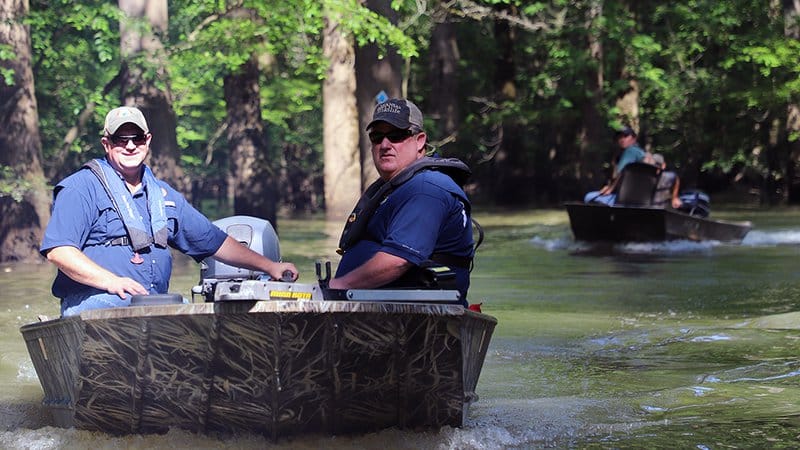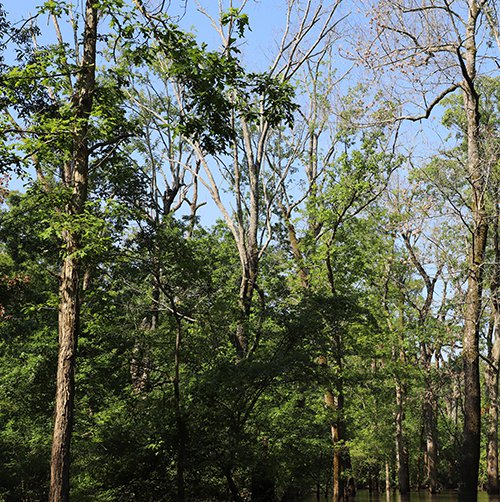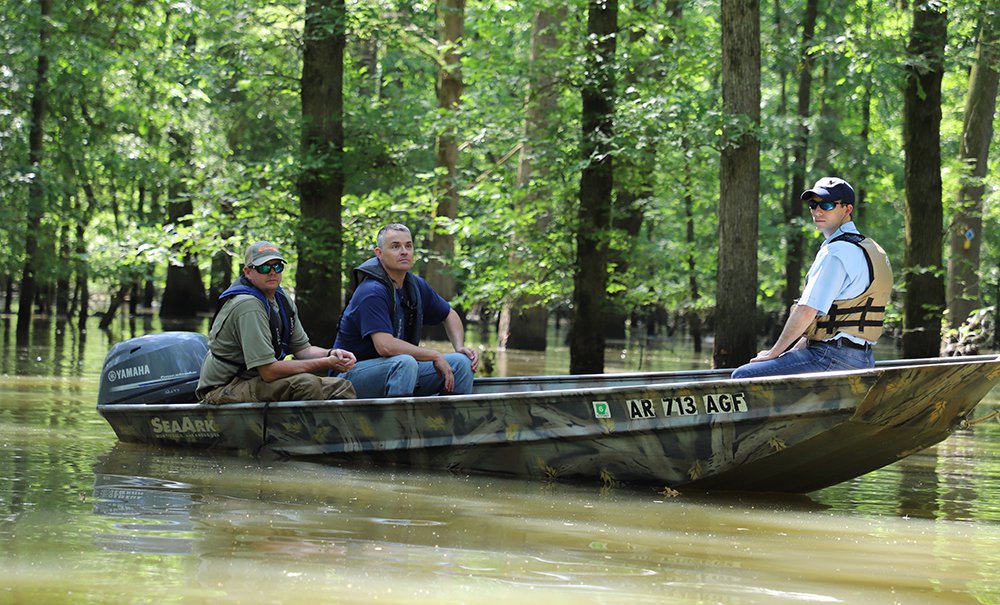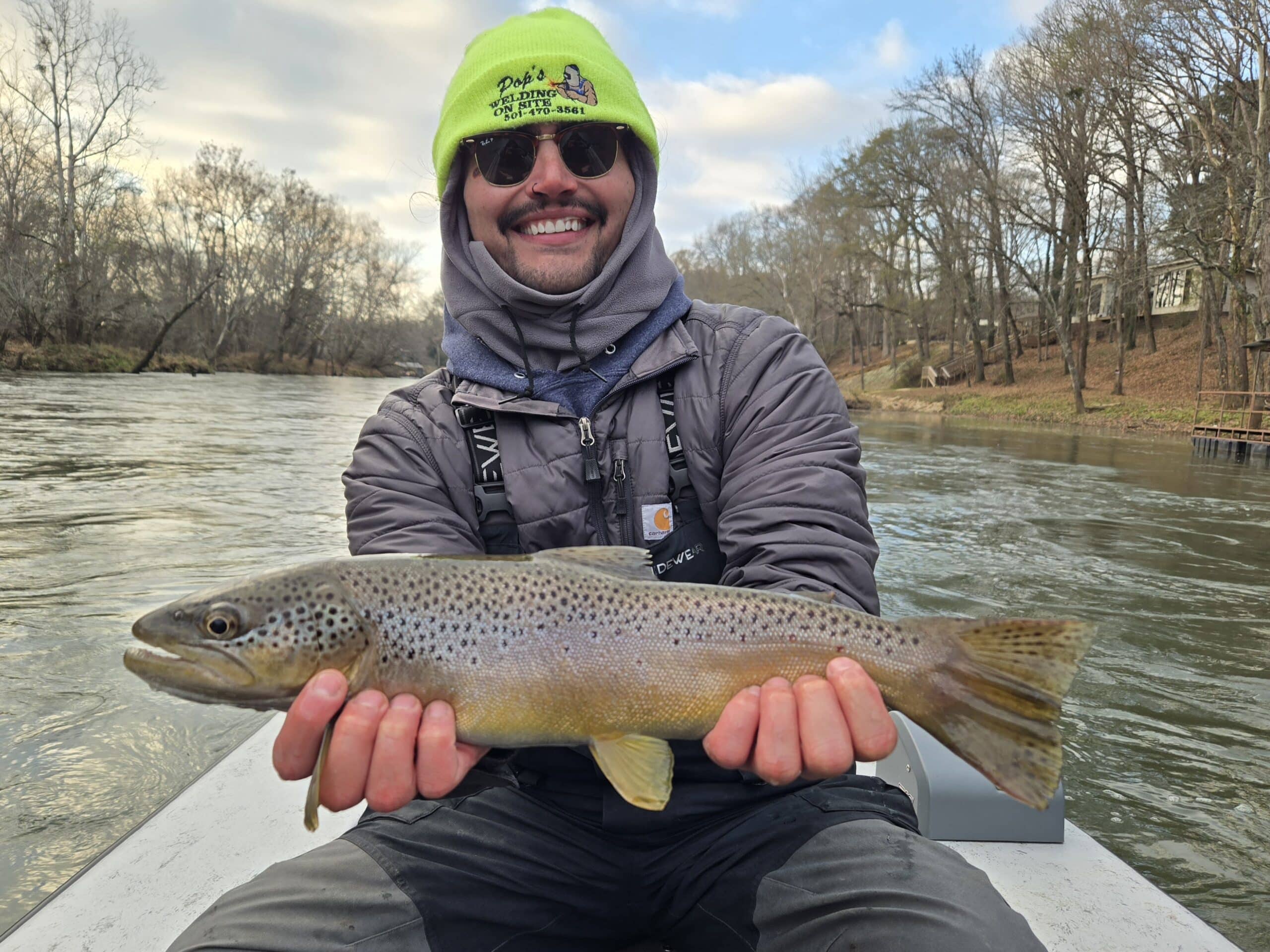Director, biologists mull changes needed in flooded Hurricane Lake WMA
BY Jim Harris
ON 07-22-2020

July 22, 2020
Jim Harris
Managing Editor Arkansas Wildlife Magazine
BALD KNOB – Kayakers would have found the South Unit of Henry Gray Hurricane Lake Wildlife Management Area inviting in June. In fact, Arkansas Game and Fish Commission Wildlife Management Division biologists had placed blue markers on trees that would be easily recognizable to paddlers who use the AGFC’s water trails around the state.
The problem is, kayakers should not be able to float this significant portion of the South Unit at this time of year. Traditionally Glaise Creek Road, running from an area where duck hunting boats launch in the winter and dividing the South Unit from the WMA’s North Unit, wouldn’t be underwater in mid- June, and the drainage ditches around the South Unit would maybe be damp from occasional rains, but more likely be dry now. That was until recent, apparent shifts in flooding patterns in the adjacent White River.
“It shouldn’t be like this, this late in June,” said Kevin Ledford, an AGFC wildlife biologist. Ledford has lived most of his 35 years in Bald Knob, except for the four he spent in college at Arkansas State University, and he’s hunted the WMA since he was 8.
On June 19, though, he was piloting one of four aluminum boats as AGFC Director Pat Fitts, Deputy Director Chris Racey and various members of the AGFC’s Wildlife Management Division surveyed the high water inundating the South Unit, this at a time when the ground around the red oaks and other trees vital to winter duck habitat should be dry. Trees do their growing from March to October.
In 2016, AGFC biologists expressed significant concerns regarding observed forest health deterioration at the WMA. Prolonged flooding within the WMA has continued since that time. Beginning in late summer 2018, staff members began to observe patches of recently dead and dying trees throughout the South Unit. Last year, AGFC biologists noted the deadening had doubled in size, with 400 acres of dead or dying trees in the South Unit and another 800 acres worth that were suffering from the effects of die-off, which happens when stagnant water stays on the trees throughout the growing season. The trees typically go dormant in mid- to late fall, and the first buds indicating the restart of the growing season might appear with the arrival of spring. The White River has naturally flooded in spring for eons, but it was always a rise-and-fall flood. Meanwhile, the landscape for decades has been managed to help waterfowl hunters by using control structures to hold water in these greentree reservoirs during the dormant season, creating waterfowl habitat and hunting opportunities.
Hydrology has impacted how the AGFC can manage its greentree reservoirs now, and biologists note that not all of the areas around the state are the same or face the same concerns. In Hurricane Lake WMA’s case, its North and South units are fed by Cutoff Creek and Glaise Creek, a White River tributary.
The White River has stayed out of its banks in this area since last November, according to Garrick Dugger, assistant chief of the Wildlife Management Division. It was high throughout the spring and most of the summer in 2019, too.The water has dropped slightly since the June 19 tour, but it is still well within the South Unit.
The White River system simply has lots of water and few places to send it. Bull Shoals Lake has been over 30 feet above normal conservation pool for months. Norfork Dam, below it, drains water from the North Fork of the White River into the White, and has been more than 20 feet above normal.
The Corps has a balancing act with how much water it can release to meet its maximum flow at Newport and at Georgetown. The Little Red River dumps in before the river reaches Georgetown, and Greers Ferry Lake, which holds water back from the Little Red, has also been high for months, but was down to 1.2 feet above conservation pool July 7.
There’s more to all the hydrology, but this paints some of the picture of why water stays in the woods now in Hurricane Lake WMA. “It’s been like this for five years or more,” Dugger said.
The AGFC has been addressing the situation since the tree die-off was observed. The South Unit was taken out of greentree reservoir management two years ago, meaning no boards were placed in the water control structures to hold water during duck season. The North Unit was operated as it had been since 2016, with boards put in place on Nov. 15, which has now been the plan for all AGFC’s greentree reservoirs for the past three years. Also, a private company was brought in to mulch and clear several miles of drains in the South Unit to help with water flow back to the Little Red River.
One might ask, why not put the boards in at the South Unit to perhaps keep water out? It won’t keep the water out. Once the water level rises above 192 feet (mean sea level) in Glaise Creek, the water is going over the water control structures anyway, and that’s been the case for many months, Dugger said.

It’s been noted that a complete overhaul of the aging control structures for all the greentree reservoir systems would cost millions, and AGFC staff are working with partners to find revenue streams for these major projects.
Luke Naylor, the AGFC’s waterfowl program coordinator, and Jason Jackson, the AGFC’s wetland program coordinator, both noted that conservation partners are in the final approval stage of obtaining federal help by way of a $1 million North American Wetlands Conservation Act grant to Ducks Unlimited that would be used to restore hydrology in the South Unit.
“The area will still flood and create some waterfowl hunting opportunity and habitat, but will not artificially hold the water at a constant level,” Jackson said. “That’s the key to managing these systems, keep the water moving and let it flow out quickly during the growing season.”
Recent News

CWD-positive deer found in Grant, Sevier counties
Dec. 19, 2025

Arkansas Wildlife Weekly Fishing Report
Dec. 18, 2025
Subscribe to Our Weekly Newsletter E-mails
Don’t miss another issue. Sign up now to receive the AGFC Wildlife Weekly Newsletter in your mailbox every Wednesday afternoon (Waterfowl Reports are published weekly during waterfowl season and periodically outside the season). Fishing Reports arrive on Thursdays. Fill in the following fields and hit submit. Thanks, and welcome!
